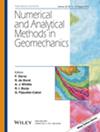Molecular Dynamics Study on Quartz‐Indenter Shape and Depth Effects in Epoxy Interfacial Mechanics
IF 3.6
2区 工程技术
Q2 ENGINEERING, GEOLOGICAL
International Journal for Numerical and Analytical Methods in Geomechanics
Pub Date : 2025-06-16
DOI:10.1002/nag.4021
引用次数: 0
Abstract
The interfacial mechanical behavior between epoxy and quartz at the microscale remains inadequately understood. The quartz‐indenter shape and indentation depth (环氧界面力学中石英压头形状和深度影响的分子动力学研究
在微观尺度上,环氧树脂与石英之间的界面力学行为尚不清楚。通过分子动力学(MD)模拟纳米压痕和纳米划痕,研究了石英压痕形状和压痕深度(hc)对环氧树脂界面力学行为的影响。这项工作采用了两个维氏型和四个不同半径(R)的球形压头,在不同的hc条件下,揭示了微观尺度下的基本变形机制。MD模拟得到的环氧树脂的还原模量和杨氏模量与实验结果吻合较好。主要发现包括:(1)在MD纳米压痕过程中,环氧树脂的弹塑性变形和压痕力随着R和hc的升高而增大,这是由于环氧树脂与石英之间的界面相互作用增强所致。(2)在卸载阶段,由于粘附效应,观察到负压痕力。(3)在MD纳米划痕中,随着R和hc的增加,y -和z -方向上的力增加,这是由于接触区和弹塑性变形的增加。(4)摩擦系数随压痕深度的增加而增大,在hc/R >时超过1.0;0.75. (5)经典的库仑摩擦定律在微观尺度和纳米尺度上都不适用。这些结果为在宏观尺度上建立工程应用的界面模型提供了基础。
本文章由计算机程序翻译,如有差异,请以英文原文为准。
求助全文
约1分钟内获得全文
求助全文
来源期刊
CiteScore
6.40
自引率
12.50%
发文量
160
审稿时长
9 months
期刊介绍:
The journal welcomes manuscripts that substantially contribute to the understanding of the complex mechanical behaviour of geomaterials (soils, rocks, concrete, ice, snow, and powders), through innovative experimental techniques, and/or through the development of novel numerical or hybrid experimental/numerical modelling concepts in geomechanics. Topics of interest include instabilities and localization, interface and surface phenomena, fracture and failure, multi-physics and other time-dependent phenomena, micromechanics and multi-scale methods, and inverse analysis and stochastic methods. Papers related to energy and environmental issues are particularly welcome. The illustration of the proposed methods and techniques to engineering problems is encouraged. However, manuscripts dealing with applications of existing methods, or proposing incremental improvements to existing methods – in particular marginal extensions of existing analytical solutions or numerical methods – will not be considered for review.

 求助内容:
求助内容: 应助结果提醒方式:
应助结果提醒方式:


